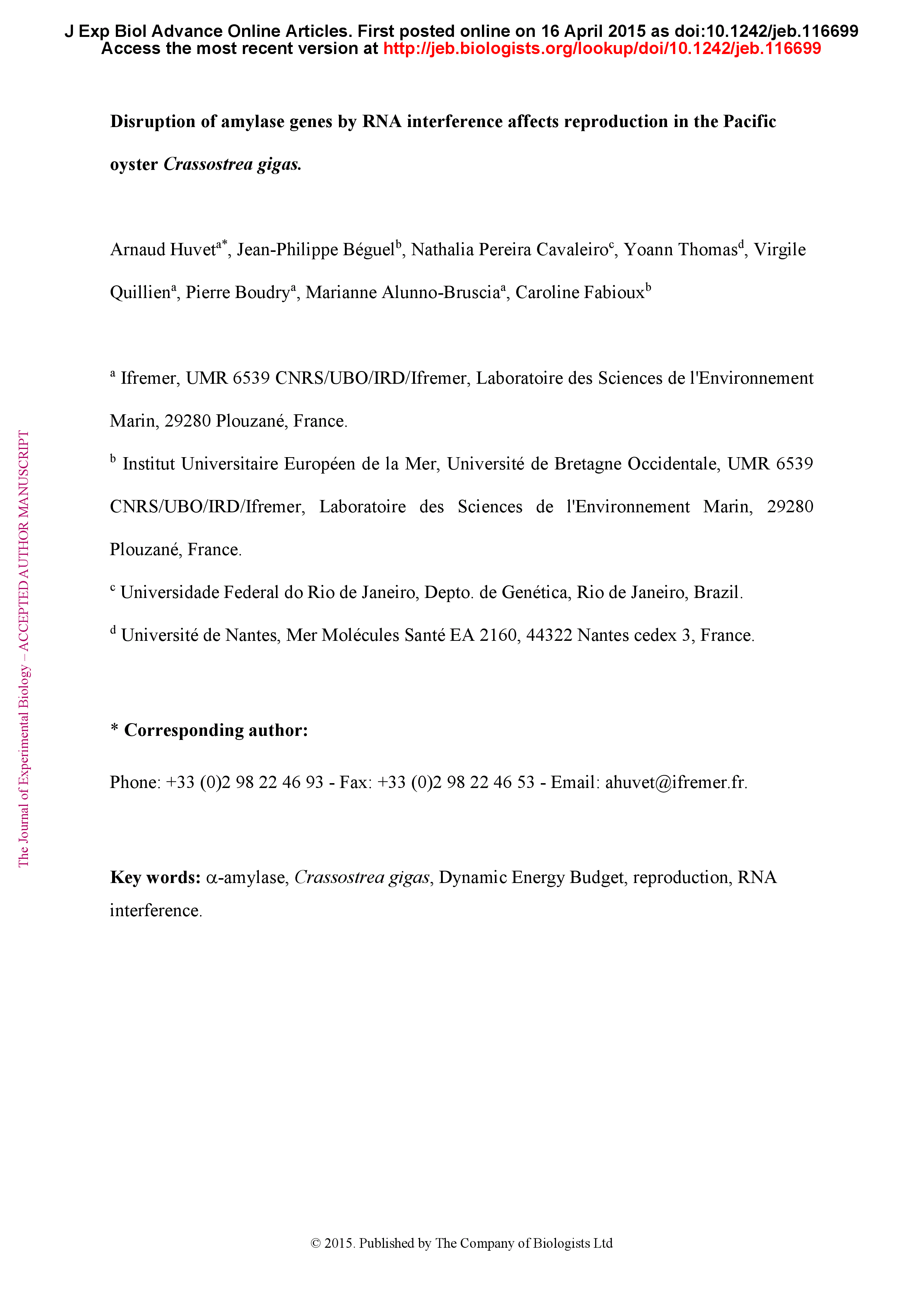Feeding strategies and digestive capacities can have important implications for variation in energetic pathways associated with ecological and economically important traits, such as growth or reproduction in bivalve species. Here, we investigated the role of amylase in the digestive processes of Crassostrea gigas, using in vivo RNA interference. This approach also allowed us to investigate the relationship between energy intake by feeding and gametogenesis in oysters. Double-stranded RNA designed to target the two α-amylase genes A and B was injected in vivo into the visceral mass of oysters at two doses. These treatments caused significant reductions in mean mRNA levels of the amylase genes: −50.7 and −59% (mRNA A), and −71.9 and −70.6% (mRNA B) in 15 and 75 µg dsRNA-injected oysters, respectively, relative to controls. Interestingly, reproductive knock-down phenotypes were observed for both sexes at 48 days post injection, with a significant reduction of the gonad area (−22.5% relative to controls) and germ cell under-proliferation revealed by histology. In response to the higher dose of dsRNA, we also observed reductions in amylase activity (−53%) and absorption efficiency (−5%). Based on these data, dynamic energy budget modeling showed that the limitation of energy intake by feeding that was induced by injection of amylase dsRNA was clearly insufficient to affect gonadic development at the level observed in the present study. This finding suggests that other driving mechanisms, such as endogenous hormonal modulation, might significantly change energy allocation to reproduction, and increase the maintenance rate in oysters in response to dsRNA injection.
Disruption of amylase genes by RNA interference affects reproduction in the Pacific oyster Crassostrea gigas
Currently Viewing Accepted Manuscript - Newer Version Available
- Split-screen
- Views Icon Views
- Open the PDF for in another window
-
Article Versions Icon
Versions
- Version of Record 01 June 2015
- Accepted Manuscript 01 January 2015
- Share Icon Share
-
Tools Icon
Tools
- Search Site
Arnaud Huvet, Jean-Philippe Béguel, Nathalia Pereira Cavaleiro, Yoann Thomas, Virgile Quillien, Pierre Boudry, Marianne Alunno-Bruscia, Caroline Fabioux; Disruption of amylase genes by RNA interference affects reproduction in the Pacific oyster Crassostrea gigas. J Exp Biol 2015; jeb.116699. doi: https://doi.org/10.1242/jeb.116699
Download citation file:
Advertisement
2023 JEB Outstanding Paper Prize shortlist and winner

The JEB Editors are delighted to announce the shortlisted authors for the 2023 JEB Outstanding Paper Prize. Read the winning paper - Tiny spies: mosquito antennae are sensitive sensors for eavesdropping on frog calls - by Hoover Pantoja-Sanchez and Brian Leavell from Ximena Bernal's lab at Purdue University, USA.
JEB Science Communication Workshop for ECRs

If you’re an early-career researcher interested in science communication and are attending the SEB Annual Conference in Prague this summer, come a day early and join the JEB Editors at a sci comm workshop to learn the key writing skills needed to promote your research to a broad audience beyond your peers (1 July at 14.30-17.30). Places are limited to 24 attendees, and applicants should apply through the SEB registration page by 30 April 2024.
Bridging the gap between controlled conditions and natural habitats in understanding behaviour

Novel technologies enable behavioural experiments with non-model species, in naturalistic habitats and with underexplored behaviours. In their Commentary, Scholz and colleagues discuss how to obtain a deeper understanding of the natural ecology and lifestyle of study animals.
Beluga metabolic measures could help save species

To help save animals from extinction, it’s important to understand what each species needs to survive. This led Jason John et al. to measure the metabolic rates of captive belugas to develop a ‘fish calculator’ showing that the whales need to eat ~23 salmon per day.
ECR Workshop on Positive Peer Review

Are you an ECR looking for tips on how to write concise, astute and useful manuscript reviews? If so, join the JEB Editors at a 2-hour JEB-sponsored Workshop on Positive Peer Review at the Canadian Society of Zoologists annual meeting in Moncton on 9 May 2024 at 13.00-15.00. There are 25 spaces for ECRs and selection is first come, first serve. To sign up, check the ECR Workshop box when you register for the CSZ meeting.



